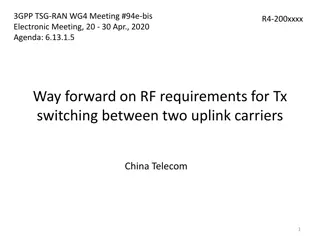Understanding Business Interruption Insurance Policies
Business Interruption (BI) insurance covers loss of gross profit due to reduction in turnover or increase in cost of working expenditure. The policy operates on the principle of indemnity, aiming to restore the client financially to a pre-loss position. Different variants exist for sum insured and basis of indemnification. This insurance is triggered when property used for business purposes is damaged by covered perils, causing interruption. Various nomenclatures and clauses are used to specify the coverage and conditions. Understanding the gross profit concept, indemnity period, and insuring clauses is crucial for leveraging BI coverage effectively.
- Business Interruption Insurance
- Policy Coverage
- Indemnity Principle
- Insuring Clauses
- Loss Compensation
Download Presentation

Please find below an Image/Link to download the presentation.
The content on the website is provided AS IS for your information and personal use only. It may not be sold, licensed, or shared on other websites without obtaining consent from the author. Download presentation by click this link. If you encounter any issues during the download, it is possible that the publisher has removed the file from their server.
E N D
Presentation Transcript
Nomenclature for BI policy Different Names of BI Consequential Loss Loss of Profits Business interruption Time element losses Soft Costs Loss of Business Income Depending on Underlying Peril Set FLOP BI section of IAR with MD section perils as underlying MLOP ALOP DSU
Understanding BI The BI Policy operates on Principle of Indemnity. It endeavours to put the Client back into Pre loss Position Financially. Multiple variants / specifications for fixing up of Sum Insured /Basis of Indemnification available in the market GP Turn Over( Addition/Difference) GP-Output Gross Revenue Gross Fees basis. Gross Profit(Turn Over) & Gross Revenue basis are popular. Switching from Turn Over to Output enabled by Alternative basis clause. BI applicable for both Mfg- Thermal /Steel / Autos/Petrochemical & Non Mfg Risks Hotels/SW/ Occupancy(Petrochem/Non Petrochem) & Continuous/Non continuous nature/ IP used to determine the FLOP Rate but now 100% SFSP Rate.
Understanding BI Understanding GP : Gross Profit is that portion of Turn Over which is exposed for Loss following an MD event. Understanding IP: This is the Period during which Insurance payments are made. Indemnity period is chosen by the Insured based on their assessment of Worst case scenario and its the Period during which Insurer pays for Loss of GP commencing with the Time of Loss and ending with IP or restoration of Pre loss TO whichever is earlier.
What BI covers The insurance is limited to loss of Gross Profit due to (a) Reduction in Turnover and (b) increase in Cost of Working expenditure #b is Conditioned by necessarily and reasonably incurred Sole purpose test Economic Limit
Insuring Clause A. Subjectivities: Terms and conditions of LOP as well as MD policy- covering the Interest of the Insured at the Premises. B. Trigger:if any building or other property or any part thereof used by the Insured at the premises1for the purpose of the Business2, be destroyed or damaged by the perils covered under the fire policy3, and the Business carried on4 by the Insured at the Premises be in consequence thereof interrupted or interfered with. C. Material damage (Insurance)Proviso
Business Interruption and Pandemics Coverage of BI is examined during Pandemics Material Damage proviso Responds only to direct physical loss or damage Can Virus cause physical damage ?
Definitions Gross Profit = SC+Net Profit / SC-Net Loss } Addition basis = (Turnover UWE) } Difference basis =(TO+ Closingg Stock) (Opening Stock+ UWE) } Difference basis Notes This is a Measure of Loss a Business would suffer post a MD incident and hence fixed as Sum Insured in proportion to IP. This is not the same as an accountant's definition of gross profit - a fact which leads to much confusion and underinsurance. Accountant s GP does not contain Standing charges and shows the PBT as GP. The gross profit basis of cover is generally used for manufacturing risks where the business has costs that vary in direct proportion to turnover. Addition basis Insured can omit some EXPENSES thinking them as variable to find out that they are SC during the IP. Difference basis- As WEs are omitted from the TO , little chance of above.
Definitions 2. 3. Net Profit Turn Over course of Business. At the premises. Payments may be made in stages outside the indemnity period even though the work was done within this time. In this situation, unless the additional words "or earned" are added, the policy would not respond. The actual loss sustained by a business is not the Loss of Turnover, as there are variable costs that are not incurred . 4. Increased cost of working (ICOW): is additional costs spent to maintain the business at pre-loss levels and mitigate the loss of gross profit. = Profit before tax =Money paid or payable(or earned) for the Goods/Services done in Sole Purpose Test: expense must be for the sole purpose of avoiding or diminishing the reduction in Turnover. E.g. Air freighting an import of a machine than conventional sea freight , if it saves TO / reduces IP Economic Limit: it means that you cannot claim more as an Increased Cost of Working item than was saved by way of reduction in loss of insured gross profit. Capped by ( TO saved x RoGP)
Definition 5. Indemnity Period:The period beginning with the occurrence of the damage and ending not later than the IP selected by the Insured thereafter during which the results of the business shall be affected in consequence of the damage. IP is chosen by the Insured based on his assessment of max repair period in worst case scenario IP = Premises Restoration period IP can be Min 3 Months / max 24 months for Mfg & 36 months for Non Mfg Effect on Sum Insured: SI has to be AGP for IP of upto 12 months & beyond on Pro rata Delayed IP- The period beginning with the occurrence of the damage or the interference with the Business. Leased Premises can pose problems with the restoration as it is in Landlord s hands.
Definition 6. Standing Charges - Expenses which continue unabated after a MD loss at premises . Insured has to identify the SCs from his P& L account for insurance, which are called ISC. 7. Working Expenses over post loss. That is, if turnover reduces by 50%, the cost reduces by 50% also. No loss results the Insured and need not be insured. Also called UWE. 8. RATE OF GROSS PROFIT :The rate of Gross Profit earned on the turnover during the financial year immediately before the date of the damage. Formula = GP/TO in % 9. Annual Turn Over/Check for adequacy of SI twelve months immediately before the date of the damage. 10. Standard Turn Over :The Turnover during that Period in the twelve months immediately before the date of the damage which corresponds with the Indemnity Period. : The Expenses which reduce in direct proportion to the Turn :The Turnover during the
Definition 1. POI: 01/04/15-16 2. IP : 3 Months 3. DOL:01/06/15 4. IP:01/06/15 to 31/08/15 5. STO:01/06/14to31/08/ 14 6. ATO:01/06/14to31/05 /15 Sum Insured is benchmarked to Annual T/O to determine under Insurance
Definition 11. Alternative Trading premises Clause/Turnover Elsewhere After Damage:If Goods are sold / Services rendered from any alternative premises relating to the Insured business during IP that TO to be accounted in IPTO. 12. Departmental Clause :If the Insured s business is conducted in departments whose independent trading Results are available Loss of GP due to RTO/ICOW are separately calculated E.g. Sugar Mill Sugar /Distillery/Bio Fertiliser. Clients demand Time Excess also relating to such unit/ production line.
Definition 13. Trends & Special Circumstances clause The Clause makes the loss calculations flexible , tailoring the numbers to the reality. Loss will be measured by a formula that will be adjusted to reflect what would have happened to the business results if the clients property hadn't been damaged The BUT FOR Test. STO/ATO/RoGP are subject to adjustment Adjustments shall be made as may be necessary to provide for Trend of the business and for variations in or special circumstances affecting the business either before or after the damage or which would have affected the business had the damage not occurred So that the figures thus adjusted shall represent as nearly as may be reasonably practicable the results which, but for the damage, would have been obtained during the relative period after the damage i.e. IP.
Add On Covers in BI 1) Auditors Fees 2) Suppliers & Customers Premises Extension 3) Public Utilities of Electricity/Gas/water Premises Extension 4) Insured s Property Stored at other situations 5) Prevention of Access 6) Additional Increased Cost of Working (AICOW) 7) Interdependency or downstream business interruption, when damage at an owned location causes a loss of revenue to another owned location.
Additional ICOW This coverage extends to cover costs and expenses necessarily and reasonably incurred during the indemnity period in consequence of the 'damage' and not otherwise payable under Loss of Gross Profit provision ( increase in cost of working) for the purposes of maintaining the business. Limit: 10% of Limit of Indemnity (BI Sum insured/ BI Loss Limit) subject to a maximum amount INR 25 Cr
Gross Profit Specification 1. Loss of GP RTO Loss of GP ICOW Saving in Standing Charges =(STO-ATO) x RoGP 2. =Additional Expenditure sub limited by (TOSxRoGP) 3. 4. Total Loss of GP =(1) + (2) (-3) 5. Under Insurance application = (4) x (SI/ATO)
FLOP Policy-Problem (1) Sum Insured = Rs 80 Cr (2)IP =15 Months (3) POI =01/04/2017 to 31/03/2018 (4) Date of Loss =15/09/2017 (5) Date of Recovery =14/06/2018 ( Interruption of 9 months) (6) Standard TO =250 Cr ( 15/09/2016to14/06/2017) (7) Annual TO =1200 Cr (15/09/2016to14/09/2017 ) (8) PFY TO =1000 Cr (9) PFY GP =60 Cr (10)Actual TO IP =25 Cr (11)ICOW =50 lacs (12)Loss avoided ICOW =8 Cr (13)Savings in SC =75 Lacs
FLOP Policy- Problem Solution Solution (1) RoGP (2) Growth Trend (3) Adjusted STO (4) Loss of GP due to RITO (5) Economic Limit for ICOW =(TO savedx RoGP) (6) Payable GP =60/1000 = 6% =(ATO-PFYTO)/PFYTO % =(1200-1000)/1000 = 20% = 250x120% =300 Cr =(Adj STO-IPTO) x RoGP =(300-25)x6% =16.5 Cr 20% This will be the Trends factor =8x6% = 48 Lacs Less than Actual ICOW. =(4) +(5) Savings in Standing Charges =16.5+0.48-0.75 =16.23 Cr
FLOP Policy-Problem (7) Adjusted ATO for trends = 1200 x 120%=1440 Cr (8) Sum Required to be Insured(IP=15m) = 1440x6%x1.25=108 Cr (9) Payable GP adjusted for UI = 16.23x(80/108)=12.02 Cr (10) Time Excess - 7 days = 7xPer day STOxRoGP =7 x (250/270)x6% =0.39 Cr (11) Final payable FLOP Claim =(9) (10) =12.02-0.39 =11.63 Cr























